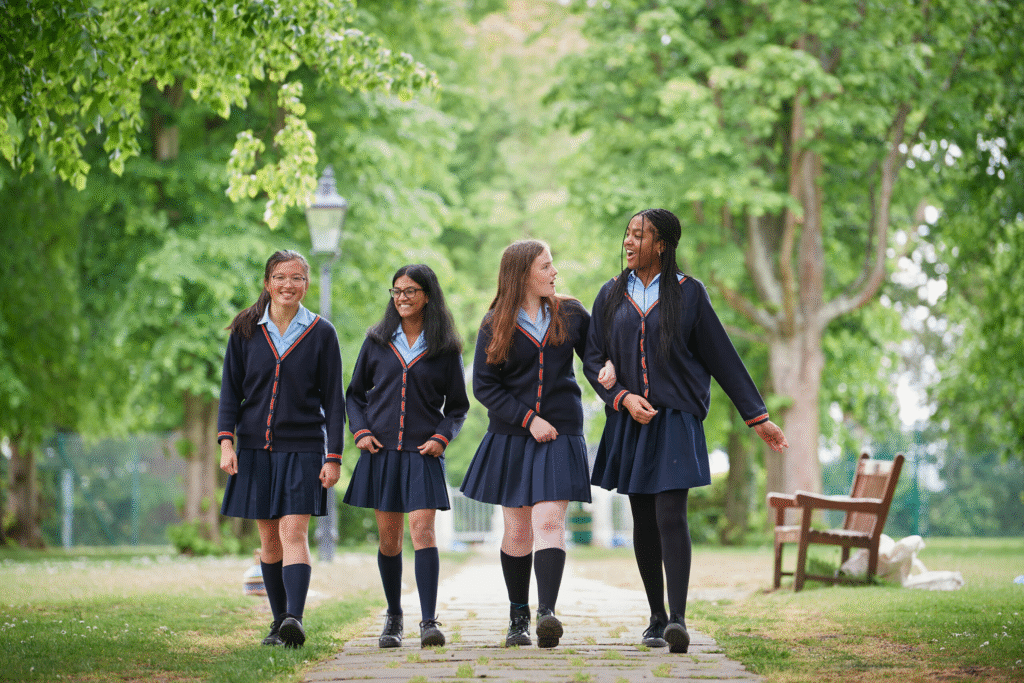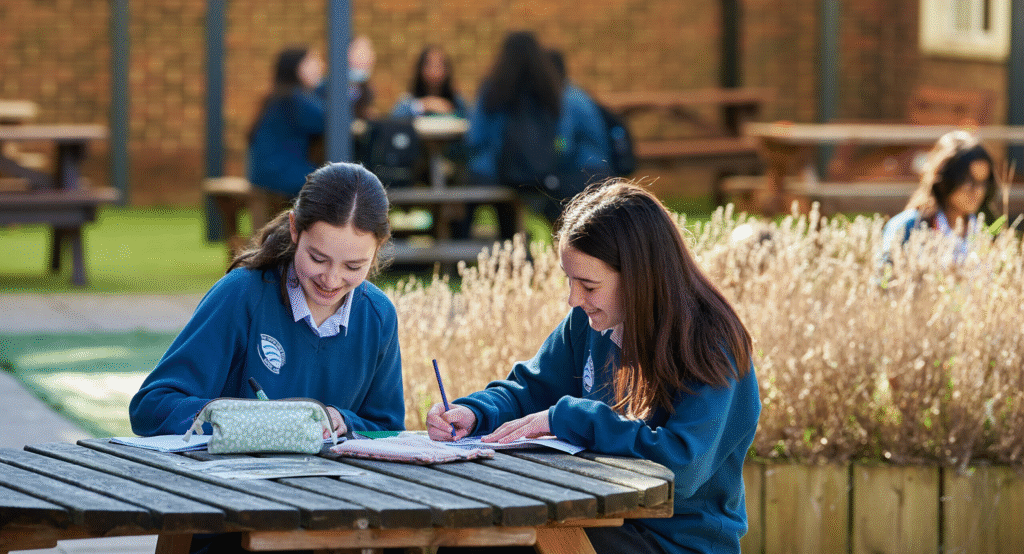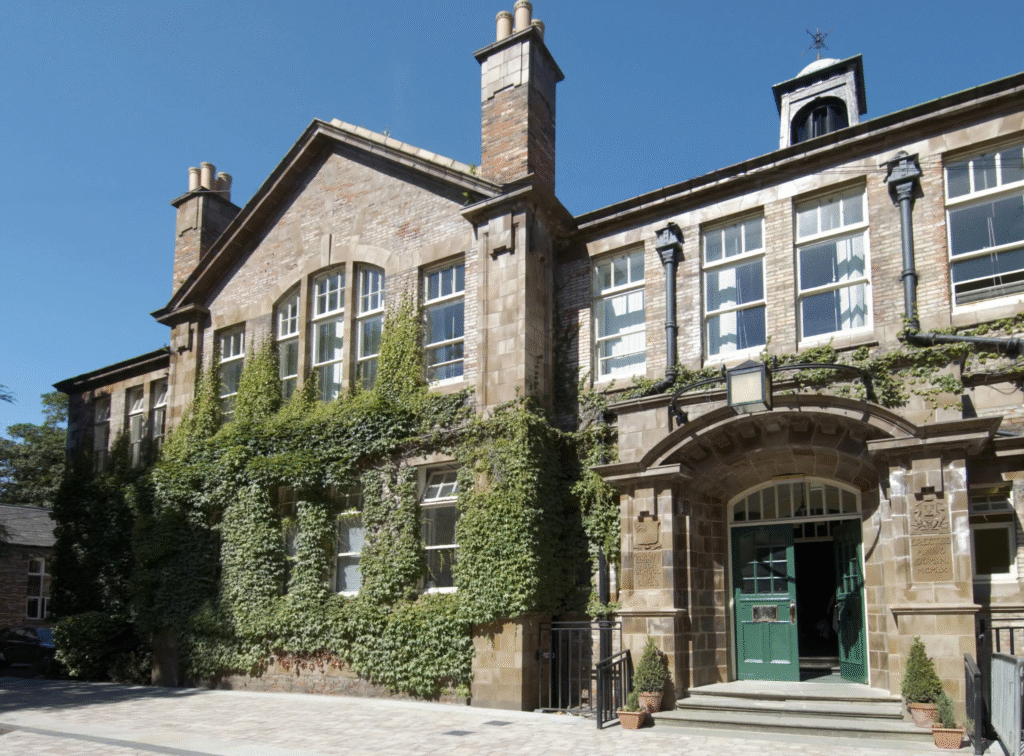Hello friends welcome to the Tigerjek.com, I am here to discus the Best Grammar Schools in UK. The United Kingdom of Great Britain and Northern Ireland (commonly called the UK) is a sovereign country located off the northwestern coast of mainland Europe. It comprises four countries: England, Scotland, Wales, Northern Ireland. Education is compulsory from ages 5 to 18. Two major systems: State-funded schools (including grammar schools) and independent schools (private). World-renowned universities: Oxford, Cambridge, Imperial College London, LSE, and more. There are the Best Grammar Schools in UK:-
Table of Contents
Henrietta Barnett School

The Henrietta Barnett School (HBS) is a non-denominational grammar school for girls aged 11-18. They became an Academy in April 2012. Founded in 1911 and situated in the peaceful surroundings of the Hampstead Garden Suburb, the school is a charming Lutyens-designed Grade II* Listed Building.
HBS is a warm, friendly and vibrant community that prides itself on happy and productive relationships. They are consistently one of the top state schools in the country and have an exemplary local and national reputation for academic excellence.
Dame Henrietta Barnett strongly believed in the power of education to shape people’s lives and founded the School to provide educational opportunities of the highest quality for its students. She built the School on the principle that education should be open to girls from different backgrounds to study and learn together and from each other. This principle is alive and well at HBS.
They provide a broad education that is ambitious, varied and stimulating. Academic excellence and a wide range of extra-curricular and enrichment opportunities are offered in an open, caring and supportive environment, enabling each individual to thrive and achieve her potential. They are committed to developing the whole person, encouraging students to explore their interests in a wide variety of ways and promoting curiosity of mind, independence of spirit and a love of learning.
In a culture of respect for others but without the need for bells or lists of imposed rules, HBS students are driven by self-motivation, self-discipline and a common purpose, a thirst for learning and a strong sense of pride in belonging to the diverse, inclusive, high-performing, friendly and supportive school community. They leave HBS full of integrity and ambition, ready and equipped to make a positive contribution to society, with the world at their fingertips.
This website will enable you to discover more about the School, but none of this replaces an experience of the School itself. Over recent years we have completed ambitious refurbishment and new build projects, including the complete refurbishment of the Queen Mary Science Wing involving the replacement of 6 outdated labs with 8 contemporary ones and the opening of two new state-of-the-art buildings that house a new Music and Drama School and an Art and Design & Technology Centre, with a Mac Suite and Cafe. THeirmost recent development is the extension and refurbishment of our Library, which is now an inspirational space, fit for purpose and loved by all.
HBS is an amazing place – do come and visit us! We would be delighted to welcome you on one of our Open Days, show you around the school and answer your questions. Please see our Admissions section for more information.
Queen Elizabeth’s School

Queen Elizabeth’s is a state-funded grammar school, with 450 years’ experience of producing confident, able and responsible young men. They provide a totally meritocratic environment, in which our boys reach their very considerable potential both in their academic and extra-curricular pursuits. The mission of Queen Elizabeth’s School aims to produce young men who are confident, able and responsible.
Founded in 1573 by Royal Charter from Queen Elizabeth I, the school has a proud history of over 450 years. Known originally as “the Free Grammar School of Queen Elizabeth in Barnet,” QE celebrated its milestone anniversary in 2023, reaffirming its mission to nurture confident, capable, and responsible young men. The school places great emphasis on building resilience, independence, and leadership in all its pupils.
Admission to QE is highly competitive. Each year, around 3,600 students apply for just 192 places in Year 7, selected via the 11-plus exam. The school does not admit external candidates into the Sixth Form, maintaining continuity and focus within its student body.
Despite an official capacity of approximately 1,200, current enrolment stands at over 1,300 students, reflecting the school’s popularity and demand. QE remains one of the most sought-after grammar schools in the UK.
A confident Elizabethan is adaptable to different contexts and secure in his own identity. He is principled, always open to learn, and prepared to challenge himself as well as others. Queen Elizabeth’s School has been part of the Barnet community since its foundation in 1573 by royal charter.
Wilson’s School

Welcome to Wilson’s School. I have been part of this truly exceptional community for nearly 20 years, and it has been my privilege to lead the school through such an exciting period of development since 2014.
Parents choose Wilson’s not just because of the outstanding academic outcomes of students but also because they understand and share the school’s values. These are encapsulated by the motto: Non Sibi Sed Omnibus (Not For Oneself, But For All). We strive to create a safe and kind environment where every pupil can become more confident and reach the highest levels of academic enjoyment and achievement. Pupils flourish at Wilson’s.
Wilson’s School are deeply proud of what they offer, particularly the hugely enriching experiences pupils enjoy beyond the classroom. Indeed these rival (and often exceed) those of fee-paying schools. Teachers engage pupils with challenging and enjoyable lessons, enriched with great activities to extend pupils’ interests and skills far beyond the National Curriculum and examination specifications. Teachers know the pupils very well and visitors often comment on the warmth and good-humour that characterise relationships between boys and members of staff.
St Olave’s Grammar School

The vision of St Olave’s Grammar School For the good education and bringing up of youth in the love, fear and knowledge of God and His most Holy word, in good nature towards the world and their parents and finally in letters and understanding of the tongues in which is hidden and laid up the treasure of all divine and human knowledge.
The origins of St. Olave’s and St. Saviour’s Grammar School go back 463 years to Shakespeare’s London and to a time when the voluntary efforts of the people of Southwark established several educational institutions for the benefit of poor ‘children and younglings’ of the parish.
In particular, the legacy of a brewer named Henry Leeke enabled St. Olave’s to begin on Michaelmas Day 1561 and to receive, from Queen Elizabeth I, its Royal Charter as a Grammar School in 1571.
The School’s Founding Vision drives the school and enables it to live up to this vision: “For the good education and bringing up of youth in the love, fear and knowledge of God and His most Holy word, in good nature towards the world and their parents and finally in letters and understanding of the tongues in which is hidden and laid up the treasure of all divine and human knowledge”.
The school moved to Orpington in 1968, having previously occupied various sites in Southwark, most recently by Tower Bridge. The present fine buildings, surrounded by over twenty acres of tree-lined playing fields, are attractively set on the edge of the Kent countryside.
Ongoing investment in buildings and refurbishment has seen a new Science Block, Sports Pavilion, Music and Sixth Form Centre, Specialist IT suite and Food Technology room, as well as a new Sport/Drama Hall and All Weather Pitch. Yet Charing Cross and the West End are little more than twenty minutes away by the fast and frequent service from Orpington Station, and the Kent and Sussex coasts are easily reached by rail or road, with the M25 Junction 4 lying within two miles.
The School’s reputation stands high and every year over 1400 pupils compete for the 128 available places in Year 7. From September 1998 girls were admitted to the Sixth Form as part of over 120 external students who join St. Olave’s post GCSE. St. Olave’s Grammar School and its ‘sister’ school – St Saviours’ and St Olave’s Girls’ school in Southwark – are both part of an Anglican Foundation; more recently St. Olave’s also became an affiliated School in the Woodard Corporation, comprising a variety of independent and maintained schools. These support a strong set of values within the context of a highly multicultural school community.
As part of ongoing links with the school’s heritage, an annual Commemoration Service, including governors, benefactors, staff, students and parents takes place in Southwark Cathedral. The treble choristers of the King’s Chapel of the Savoy are drawn exclusively from St. Olave’s, and appear on occasion before His Majesty the King and other members of the Royal family.
The Foundation, a beneficiary of The Dulwich Estate, formerly “Alleyn’s College of God’s Gift”, supports the school financially, enhancing the quality of life and the student experience at St. Olave’s.
A fascinating insight into our heritage is illustrated on this hand-carved printing block dating from around 1876. This would have been used to print certificates stating a student had passed an examination.
Pate’s Grammar School

Pate’s Grammar School is a prestigious co-educational selective grammar academy located in Cheltenham, Gloucestershire. It was founded in 1574 by Richard Pate, who endowed Corpus Christi College, Oxford, to establish both the school and an almshouse—demonstrating a legacy of educational and community commitment that continues to shape the institution’s ethos today.
Originally an all-boys school, Pate’s became co-educational in 1986 following the merger of Pate’s Grammar School for Girls with Cheltenham Grammar School. Today, it educates students aged 11 to 18, including a thriving Sixth Form.
The school is situated on Princess Elizabeth Way and operates under the Gloucestershire local authority. As of the most recent data, Pate’s enrolls approximately 1,288 students, with a nearly even split of 53% boys and 47% girls. The student body is diverse: around 25% speak English as an additional language, 5.6% have special educational needs, and 3.6% qualify for free school meals.
Academically, Pate’s Grammar School is consistently ranked among the top grammar schools in the UK. In its March 2024 Ofsted inspection, the school received an Outstanding rating across all areas, including its Sixth Form. The school has also been named “State Secondary School of the Year” by The Sunday Times on two occasions, in 2012 and 2020, and was again praised in 2025 regional rankings by The Times.
Recent exam results reflect its academic excellence:
- A-Levels (2023–24): 35.5% of grades were A*, 72% A*–A, and 92% A*–B.
- GCSEs (2024): The school saw record-breaking outcomes, with 54 students achieving the full 72 points from their top eight subjects and six students attaining grade 9 in all their GCSEs. Overall, 99.9% of students passed at grade 4 or above, 91.8% achieved grade 7 or above, and 79.7% scored grades 8 or 9.
- Key performance indicators further underscore student progress, with a Progress 8 score of 1.01 and an Attainment 8 score of 83.7.
Pate’s offers a comprehensive curriculum across Key Stage 3, 4, and Sixth Form, including subjects like Mandarin, Philosophy & Ethics, and Geography, in addition to core academic disciplines. The school was recognized as a High Performance Learning (HPL) World Class School in 2022.
The school supports a vibrant co-curricular programme, with wide-ranging activities in sports, music, drama, public speaking, and outdoor education. The House system—featuring Beaufort, Gloucester, Richmond, York, and Pembroke—promotes leadership, team spirit, and social integration. Music and drama, in particular, are standout areas; the music department has earned national recognition, and drama is a daily highlight in school life.
Since 2023, the school has been led by Dr James Richardson, whose background in educational leadership focuses on raising attainment and closing achievement gaps. Under his guidance, the school continues to foster a culture defined by the values: “Shaping the Future” and “Supporting Each Other.”
Pate’s Grammar School also boasts a rich alumni network, including composer Gustav Holst, Brian Jones (founding member of The Rolling Stones), and Green Party MP Siân Berry. With over 450 years of history, the school combines tradition with innovation, preparing students for success in a modern world while maintaining its foundational commitment to excellence and community.
The Tiffin Girls’ School

The school’s beginnings date back to the wills of brothers Thomas and John Tiffin, two wealthy Kingston brewers who were born at Yalding in Kent. In their wills in the 1630s they left a combined sum of £150 and hoped to support ‘some honest poor man’s son’ through one of the local private schools.
The Tiffin Charity also provided £5 for each pupil to be apprenticed at the end of their education. By the mid 19th century, between 30 and 50 pupils per year were being supported by the Tiffin Charity. The Endowed Schools Act of 1869 allowed the various local Kingston educational charities to be combined and by the 1870s, and with their bequest being the largest in the borough, the decision was taken to amalgamate the charities into one Kingston Schools Endowment.
Plans were drawn up for two new schools to be built, one for boys and one for girls, each taking 150 pupils. Work began to build a school in Fairfield (now St Joseph’s RC primary school) and was completed at the end of 1879. The Tiffin Girls’ School opened on 20 January 1880 under the first Headmistress Miss Rhoda Ward Fysh.
The vision of their community is vibrant, curious, creative and inspires positive change.
Colchester Royal Grammar School

With the dissolution of the monasteries by King Henry VIII, the Royal Charter of 1539 ensured revenues were granted to the bailiffs and commonality of Colchester on the condition that they founded a school; this was then enacted by the Charter of Queen Elizabeth in 1585, on condition that at least £13 6s 8d be set aside annually for the schoolmaster. Revenue from other property was also granted, but this was later challenged in court during the reign of King William III, and the arrangements were legally reconfirmed. By 1750, under the stewardship of Philip Morant, these revenues were worth £45 per annum, as well as providing scholarships for two boys to go to Cambridge University.
The school was small and run mainly out of the headmaster’s house for most of its early life, with only minor changes until 1852 when the “Big School” was built. At this time there was very little secondary education in this part of Essex, and difficulties were exacerbated through friction between the then headmaster of the school and the town’s Corporation. Student numbers dropped, although the school took in a few “parlour boarders” to prepare for Army or University entry.
This changed with the appointment of Shaw Jeffrey to become headmaster in 1900. He took over a school with 29 boarders, and barely any staff. Shaw Jeffrey’s reforms rapidly turned the school about; he introduced day boys and a prep school, a cadet corps, orchestra, bugle band, school entertainments and theatrical performances. He was a national pioneer of the teaching of modern European languages through phonetics, employed language teachers from Germany and France, and set up arrangements for foreign study during holidays. He also founded the Old Colcestrian Society to reconnect the school with its old boys, with Councillor William Gurney Benham chairing its inaugural meeting on 23 June 1901.
Altrincham Grammar School for Girls

As most of us already know, the school encompasses within itself over 100 years of rich history as an educational institute of an exceedingly high standard. What is less known, though, is the fact that part of what is now the biggest girls’ grammar school in England , in the late 19th century used to be Bowdon Lodge. Set in the County of Cheshire in the midst of spacious grounds at the meeting of Cavendish and Bowdon Road, this was a well known local landmark.
Fast-forward to 1908, and it had become a substantial, but uninhabited and derelict building. In that year, it was acquired by the Cheshire County Education Authority in order for it to be made into a school, a plan that met much opposition, as it was thought that the ‘tone’ of the neighbourhood would suffer as a result. Nevertheless, it was seen through and most of the old building was demolished to be reconstructed as what is now the main building of the school.
Two years later, on Monday the 4th of July, 1910, the school was officially opened by His Honour, Judge J K Bradbury MA., Chairman of the Board of Governors and in the presence of the first Headmistress, Miss Howes Smith MA. and many local dignitaries. On September the 14th, after 27 years of being empty, the building opened its doors to 60 boys and girls under the care of 8 members of staff.
Altrincham Grammar School for Girls (AGGS) is a distinguished institution with a proud history dating back to 1910. Over the years, it has educated generations of young women who have gone on to make a meaningful impact in their communities and far beyond. The school remains deeply committed to fostering the intellectual, social, creative, physical, moral, and spiritual development of every student.
AGGS is widely recognised for its strong traditions of academic excellence, as well as its achievements in sports, the arts, and community service. The school embraces the diversity of its community and works hard to ensure that every student feels included, supported, and valued.
At the heart of AGGS’s ethos is the development of independence, confidence, and leadership. Students are inspired through a stimulating curriculum and a wide array of extra-curricular opportunities, helping them to build high aspirations and achieve outstanding results—both in exams and beyond.
The relationship between staff and students is a particular strength of the school, with a focus on providing the very best pastoral care in a warm and nurturing environment. With student wellbeing at the centre of everything it does, AGGS is proud to offer a world-class all-round education that prepares young people not just for academic success, but for life.
Anyone visiting the school or exploring its website will quickly see the breadth of opportunities available and the energy and ambition of the impressive students who call AGGS their school.
King Edward VI Grammar School

The Endowed Schools Act of 1869 loosened the classical stranglehold and governing bodies were expanded so that they became more representative of ‘ the local population. The new governors were not afraid to assert authority over their headmasters but also felt the pressure from townspeople during some quite vitriolic campaigns for the election of parish representatives to the governing body. A broadened curriculum saw the tentative appearance of science and modem languages much to the relief of frustrated townspeople. In 1871 the law was further changed so that grammar school masters no longer had to be Anglican priests licensed by their bishop.
At the opening of the twentieth century the 1902 Education Act forbade religious instruction in the Anglican doctrine, a move welcomed by a sizeable non-conformist population in Chelmsford. The school, for the first time, also became answerable to rigorous inspection by His Majesty’s Inspectors. Their first full inspection came with stunning impact in 1907 with subsequent inspections in 1913, 1922, 1930, 1939, 1955 and 1989. The new Office for Standards in Education (OFSTED) then took over the role and inspected the school in 1996 (and again in 2006 and 2021). The 1989 and 1996 inspection reports were public documents whereas preceding reports were confidential to the governors and headmaster. There was also a full National Audit Office inspection in 1994.
Their overarching mission is for all KEGS students to be nurtured as uniquely talented individuals, finding fulfilment through their love of learning and the exploration of the furthest reaches of their intellectual, creative, physical and emotional capabilities. Their students will be guided and challenged to become principled global citizens, committed to making a contribution to the communities in which they live, to economic and environmental sustainability, and to tackling poverty and intolerance.
Enabled by a philosophy of ‘learning without limits’ students will be central to their own learning, striving to achieve at the highest possible level in an environment of mutual trust and respect that allows the ‘KEGS spirit’ to flourish. Students will develop as independent life-long learners, creative risk-takers and innovators. They will be leaders and team-players, as well as confident individuals who set themselves challenging personal and professional life goals. Please click on the link below to read the full document.
King Edward VI Camp Hill School for Girls

King Edward VI Camp Hill School for Girls aims to provide a full range of quality experiences, within a forward thinking and supportive environment. They strive to develop independent thinking, mature young adults who achieve their best and make positive contributions to school and the wider community.
They want all students to achieve their potential and enjoy their time at Camp Hill. They hope that they will work hard and participate in the whole range of academic, extra-curricular and social activities on offer. Students are actively encouraged to acquire the understanding knowledge, skills, qualifications and interests that will help them find fulfilment in their future lives and careers.
Camp Hill Girls is culturally rich and diverse, welcoming students from an extraordinary range of backgrounds. As a school community we recognise, celebrate, respect and delight in our differences, and use them as opportunities to learn and become more tolerant about the world around us. We have undertaken considerable work in recent years to develop greater diversity within our curriculum, and are committed to ensuring this work continues and develops in the years to come.
More Posts
Hi, I’m Anshul Patel, the creator of wiki.tigerjek.com and founder of TigerJek. I hold a B.Tech in Computer Science from Shri Ramswaroop Memorial University. I built this platform to share well-organized and reliable information about Education, technology, gaming, and digital topics. My goal is to make learning simple, open, and accessible for everyone who loves exploring new ideas online.
Pingback: Best Schools in Tacoma 2025 - TigerJek